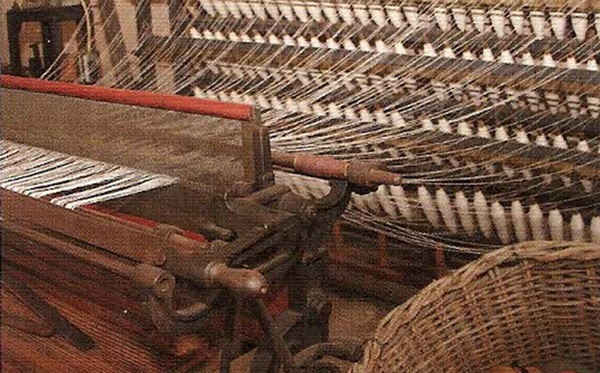 Textile weaving;
Credit: Larochette textile museum
Textile weaving;
Credit: Larochette textile museum
Known today mainly for its financial sector, Luxembourg’s economy has undergone significant changes over the years, going from an agriculture- and crafts-dominated economy to an industrial hub and a leading steel producer in the 19th and 20th centuries.
This series of articles looks at the industrial heritage of Luxembourg, from the steel industry and slate quarrying (and other forms of mining) to the textile industry and rose growing.
Next up is the Textile Industry.
Luxembourg was also home to various textile plants, tanneries, potteries, forges, breweries and paper mills over the years. Larochette in particular was considered a textile hub for more than 600 years, although Luxembourg City housed several factories as well.
Today, visitors can explore this heritage at sites such as the textile museum in Larochette. Located in an annexe of the old train station, this small industrial museum houses weaving looms and sewing machines, which can be viewed from outside by looking through the large windows. In 2021, Fairtrade Lëtzebuerg and the municipality of Larochette signed an agreement aimed at setting up a permanent exhibition about the history of the textile industry, as part of the “Rethink your clothes” awareness campaign.
As far back as the Middle Ages, John the Blind, King of Bohemia and Count of Luxembourg, authorised weavers in Larochette to use four weaving looms rather than one. Machinery helped small domestic workshops grow into factories, set up along the Ernz and Scheerbach rivers where they could harness the power of water. Weaving in Larochette reached its peak between 1870 and 1895 thanks to opportunities associated with the German Zollverein. With the opening of the market to European competition, the textile industry began to decline in the late 20th century, and the town’s last factories closed their doors in the 1970s and 1980s.
Notable textile factories in Larochette included the Draperies de Larochette, Vestimenta SA and J.P. Ginter-Ginter. The former, founded in 1856 by the Knaff brothers, brought together spinning, weaving and dyeing processes. The factory employed about ten people by the end of the 19th century. It was taken over by the influential Godchaux family in 1894, before being bought by the Ginter family in 1906. The Draperies de Larochette closed permanently in 1970.
Larochette was also home to a wire factory, a brush factory, various tanneries and a shoe factory. The Sinner-Steichen brewery (Osterbour) and the Ernzen sandstone quarries were also located nearby.
Further north, the “Duch vum Séi”, a former cloth factory in the Upper Sûre Nature Park, features an exhibition on the history of wool processing and cloth production in the region. A weavers’ guild existed in Esch-sur-Sûre as early as the 16th century. Martin Schoetter-Greisch built a fulling mill in the area back in 1807. The factory was expanded in 1866 and taken over by the Demuth family in 1901. It closed its doors in 1975 but was later purchased by the SYCOPAN intermunicipal union in 1990 in the interest of preserving industrial heritage. The restored machines are still used to produce woollen cloth today, during guided tours of the museum. The regional shop also sells various textile products.
In Luxembourg City, the entrepreneurial Godchaux brothers set up a weaving mill in Pfaffenthal and then a cloth factory in Schläifmillen (between Hamm and Bonnevoie) in the late 1820s to early 1830s. The family expanded their business with subsidiaries in Luxembourg and abroad. At its peak, the factory employed 800 people. Closed in 1939, after the First World War and the loss of the German market, the old Schläifmillen cloth factory has since been reclaimed by nature and has become a popular recreational area; it also houses an artists’ centre and gallery. The Godchaux brothers are credited with having laid the foundations for the textile industry boom in the Alzette Valley in the early 19th century. The Godchaux Circular Walk offers visitors an opportunity to learn about the origins of industrialisation in the suburbs of Luxembourg City.
Another notable example in Luxembourg City is the old glove factory established by Albert Reinhard in the Grund district (Rue Plaetis) in 1882. For a time, the factory and adjoining tannery served as the city’s largest industrial site, employing up to 1,000 people (including many women). Reinhard went on to expand the business, establishing glove-making workshops in Esch-sur-Sûre, Wiltz and Vianden, as well as a dyeing factory (between 1902 and 1933), and exporting internationally. The Grund factory burned down in December 1904 but was later rebuilt and extended. In 1940, German occupiers confiscated the factory as Jewish property. They shut down the factory but later used it to produce gas masks. Glove manufacturing resumed around 1945, but operations ceased in the 1950s. In 1985, the building was restored and converted into apartments.








